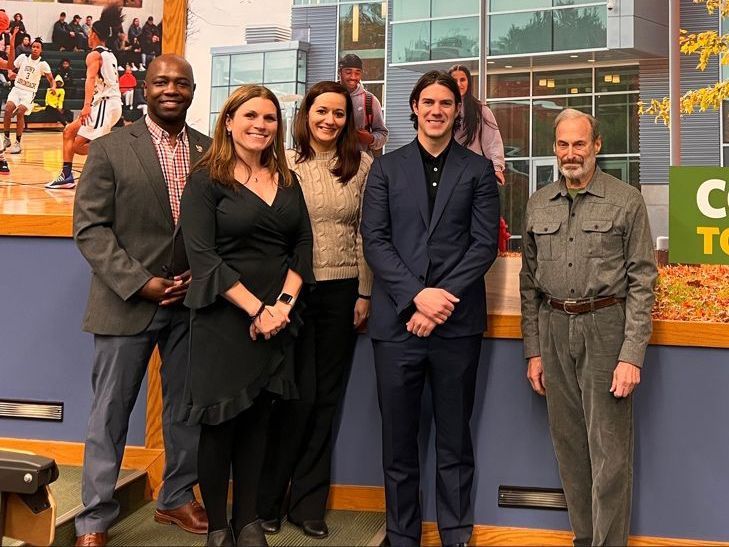Looking out over the verdant, rolling acreage at Dancing Grain Farm Brewery, owner Rachel McDermott sees opportunity… More specifically, she sees 6,500 square feet of opportunity. That’s because, after just two short years of operation, Dancing Grain is already in a position to expand.
Leased for the first time by McDermott’s father and uncle back in the 1980’s, the land in Moreau, NY that Dancing Grain now calls home was originally just 230 acres. Its original focus was on producing corn, soybeans, hay and straw… Several decades later, spanning a period in which the property would experience a full tornado and decreasing land bases, the family fully purchased the farmland and the remaining pieces of the original farmstead. Immediately upon doing so, McDermott and her team set to work on outlining a new, and sustainable vision for the future.
DGFB Motto: More out of Less
A capital region native, McDermott grew up in the farming industry with her father, Jim, and uncle, Bob, at her side teaching her the ropes. Although she left the area to attend college at Cornell University, followed by a short stint in the corporate world, McDermott knew that home was where she belonged, and eventually returned to help run the family farm back in 2016.
“When it came to looking to the future, the biggest question at the time for us was, ‘How do we make more with less?'” Referencing a world with shrinking farmland, an economy with higher production prices, and a society that is always looking to the newest and latest, McDermott and her family were determined to find a way to capitalize on the operation they already had established… The final solution? Craft beer, with ingredients cultivated through vertical integration and regenerative farming.
Visions Become Reality
“There are a lot of options in craft beer,” said McDermott. “And a lot of them are very great. What sets us apart however is that we not only craft our own brews, we produce the main ingredients used to make them.” According to their website, DGFB is proud to highlight that over 90% of their ingredients are sourced from their own fields, a statistic not often seen when it comes to craft brews.
We had McDermott elaborate a bit further on how this can be done: “When we originally sat down to think about how to expand our operation, we knew we wanted to enter a sphere that complimented what we already had established,” said McDermott. She continued on to explain how, “at the time, we saw how up and coming the craft brew sector was , and noted that the main ingredients that are needed – grains like malting barley, distillers’ rye, and corn – fit in easily into the rotation of cash crops that our pre-withstanding farm was already built around.”
McDermott elaborated on how, “our team was really excited about this, because not only did this mean we could grow many of the ingredients needed right on our own land, but the ingredients themselves would actually benefit what we already had going… For example, grains help to restore some natural compounds in the earth, like nitrogen, that some of our other products, like soybeans, take out.”
In the end, McDermott acknowledged that “we know that all industries cost something to the land, but with what we were envisioning, we saw how we could institute not just clean farming practices when producing, but truly integrate regenerative farming techniques as well to help minimize the negative impact we may leave behind,” said McDermott.
With a holistic concept secured, and a full 308 acres under their control, the DGFB team began to upgrade the farm by investing in 115,000 feet of tile drainage to increase soil health, fertility, and lengthen the growing season. Dually, McDermott also worked directly with local and regional brewers and distillers to create a specialty grains program designed to enhance the quality and usability of malting barley, distillers’ rye, and corn.
Finally, after several research trials conducted between 2017 and 2021, the team was able to move to the next stage of their vision – a brewhouse and taproom.
Dancing Grain Today
In line with their “more with less” motto, when it came time to develop a structure that would house the next part of their project, the DGFB team thought: “Why don’t we utilize the land and buildings we already own?” referencing the dilapidated farmstead structures they inherited when they purchased the entirety of the farm.
Though it was in rough shape at the start, by hiring a local company to refurbish and renovate one of the barns, the team was able to breathe new life into the space. Today, Dancing Grain is home to a three-and-a-half barrel brewhouse which, in a completely intentional move, also houses their farm style taproom: “When you walk into the taproom you can completely see into the brewhouse. That’s on purpose. We wanted everything to be completely transparent to the customer,” said McDermott.
She continued on to explain “While we want our customers to enjoy their favorite brews, we also want them to understand that everything that we pour into those glasses is just one part of the story. The bigger picture: that of sustainable ingredients, which are sourced through regenerative farming practices, which were developed with intention, and so on and so forth; is all really in an effort to ensure that the products we make here do not take more from the land than they give back to it in some way.”
Officially opened in 2022, the current space is open year round and boasts 14 specially cultivated brews. Throughout the year, one can also find a number of specialty events and themed nights to enjoy with family and friends.
Always Looking Forward
Never ones to stop moving forward, the Dancing Grain family has big plans in 2024 to expand their offerings to the community – McDermott is about to begin a refurbishment project on a second building on the property.
To be opened as a secondary space, focused on community events and gatherings, the barn renovation will be a gorgeous 6,500 square-foot space that will allow Dancing Grain to host events all year round, without requiring them to close their main taproom off to the public. “We see this space as becoming a true part of the community in the years to come. From fundraisers, to weddings, to just an everyday open air picnic space for families. We hope this place transforms into something that community life breathes through in every aspect.”
Connect with Dancing Grain
“We want you to ask about our story!” said McDermott, encouraging anyone who’s interested in learning more to connect with the team or visit the taproom in Moreau.
For those interested in connecting with or visiting Dancing Grain, please visit their website at www.dancinggrain.com today.
























